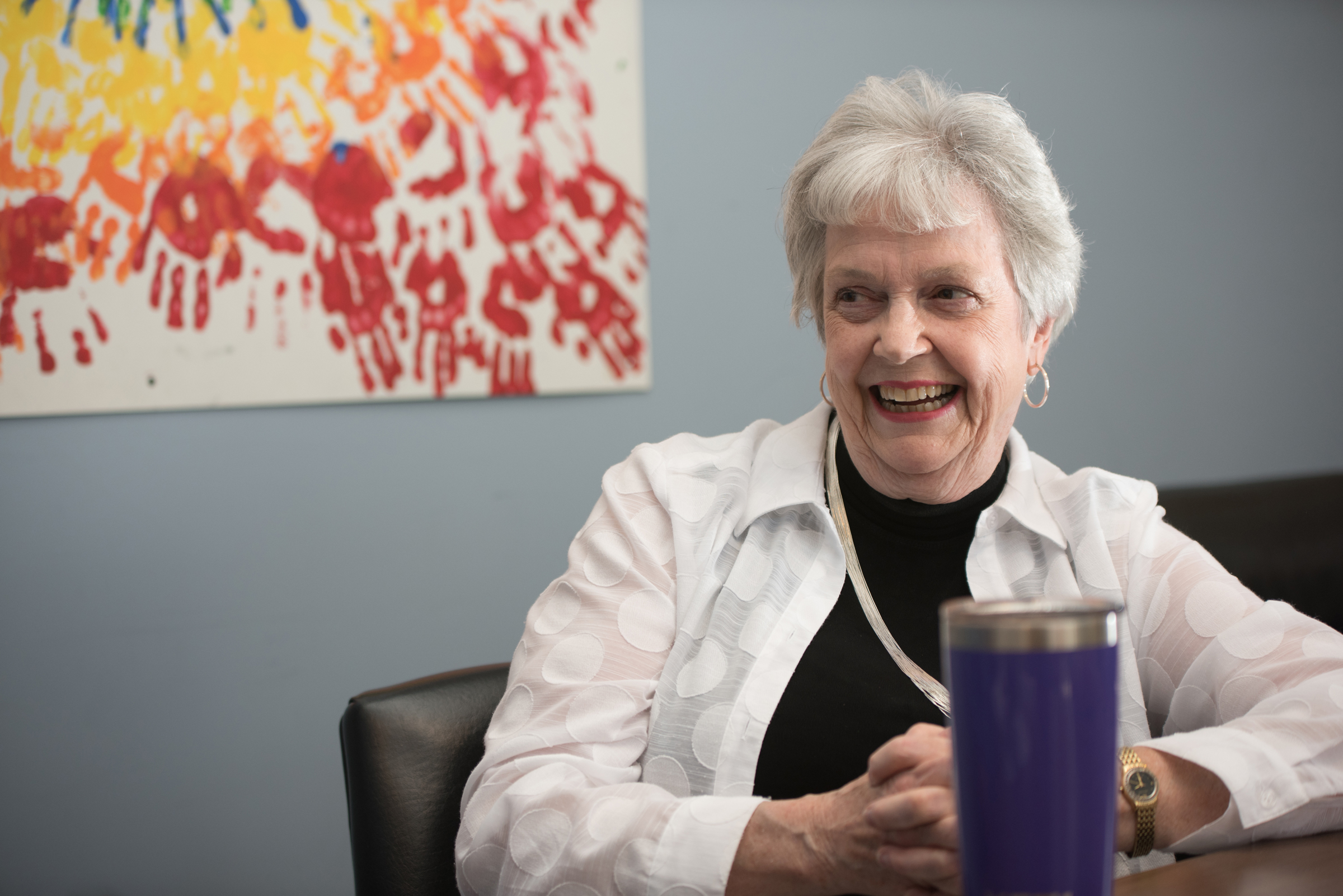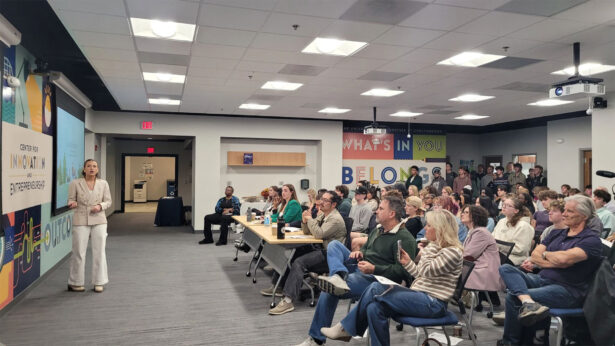Photos by Angela Foster
Scott Kramer (Chattanooga ’14) has lived with the challenges of autism since an infant, but like so many adults on the spectrum, he lacked an official diagnosis until he was well into adulthood.
Most people with autism are adults, and most of these adults lack support services and even diagnoses. In fact, research is far behind on how autism affects adults; only 1 percent of all autism research goes toward studying topics related to adults on the spectrum.
“When the tools became available back in the 1990s to diagnose children with autism, the medical professionals had to start someplace, so they started with the young people,” Kramer says. “And people like me were pretty much left out.”
After being diagnosed at age 40, Kramer hit the streets, checking with nonprofits about services for adults on the spectrum, and what he heard over and over was disheartening.
“No, no, no, no, no,” recalls Kramer. “That’s when I knew I had to just start something myself.”
Today, Kramer is program director of Greater Chattanooga Aspies (GCA) Centre for Adult Autism, a program of the Chattanooga Autism Center, and program coordinator of the Southeast Adult Autism Symposium in Chattanooga. Kramer also leads a support group for adults on the spectrum.
“I didn’t speak until I was 4. My mom took me to a children’s hospital in Chicago back in the 1970s. Something obviously was different about me, but the doctors didn’t have the knowledge of what was wrong with me, so they told my mom that I was mentally retarded,” Kramer says. “My mom never believed that. She did the best she could and taught me social skills.”
The symposium included speakers and exhibits on topics ranging from employment and social relationships to health care and independent living.
Dave Buck, executive director of the Chattanooga Autism Center, explains that autism is difficult to define, but all people with autism display three characteristics—although they may present in very different ways, adding to the difficulty to diagnosis.
The first characteristic is some type of sensory difference. Buck explains that this may mean an aversion to something—a particular type of sound or light or a texture. On the other hand, an individual may be sensory seeking.

“This is different for every individual,” Buck says. “It might be something they are sensitive to that affects their lives, or it might be something they like to hear or see, and they may obsess on that. Whatever it is, everyone with autism will have sensory difference.”
The second characteristic deals with language, and again, the signs are different for each person. Some individuals have no language or speak very little. Others have extensive vocabularies but struggle in social situations.
“Sometimes it depends on how they use their language,” Buck says. “It can also be affected by when language develops for someone.”
The third characteristic is the most difficult to define and recognize because it deals with taking the perspective of others.
“Every single person with autism will have some type of difficulty, or sometimes impossibility, of taking the perspective of another individual,” Buck says. “It can be developed over time and get better, but it has to do with the concept that a person with autism has difficulty understanding that another person would see something differently than them in the moment.”
A most simplistic example of this would be an autistic person telling a joke that seems very funny to the individual, but others do not find it humorous.
“The individual with autism would have trouble understanding why the joke was not funny to anyone else,” Buck says.
While both Buck and Kramer say that increased awareness of autism spectrum disorder has brought about more opportunities and understanding, popular media portrayals of individuals on the spectrum can also be overly simplistic.
“It’s one thing to see the perspective of an actor portraying someone with autism, and I get that,” Kramer says. “It’s a totally different perspective for someone who’s actually living that each and every day. I’m not sure society as a whole can see that, that they can make that distinction. I don’t think they get the whole flavor of what it’s all about until they actually see somebody who is living on the spectrum.”
Just as Capable

Growing up, Nathan Zimmerman was told he had a learning disability.
“They didn’t have a name for it when I was a kid,” says Zimmerman, who was born in 1979. “We didn’t get the resources we needed in school. I kept telling my teachers, ‘I need this. I need that. I need help.’ But it went on deaf ears because they didn’t understand.”
Reading and writing just never came easily for Zimmerman.
“My mom was smart enough to get me an Apple 2C when I was 5 years old, and that’s how I learned the computer,” he says. “It became a necessity. And then, over time, I learned how to modify my computer and give it voice characteristics to speak to me. I started learning how to modify it just to make it more useful as a tool.”
Zimmerman was diagnosed with Asperger’s syndrome at 34 and attends the Greater Chattanooga Aspies Centre for Adult Autism.
He still does everything on his computer. One major misconception about autism is that individuals on the spectrum try to avoid people, Zimmerman says. Although making social connections can be difficult for them, people on the spectrum desire social interaction as much as anyone else.
Zimmerman, who is employed and lives independently, doesn’t use his computer to avoid people.
“For a lot of people on the spectrum, they can’t function without their computers. You take away their computers, you take away some of their functionality,” he says. “You take away my computer, I can’t pay my bills. I can’t read my emails. I can’t send out things or read things because my computer does all of that dictation stuff.
“We are just as capable as other people. We don’t want to be seen as different. We want to be socially accepted for who we are.”
Autism Facts
One in 68 people are on the autism spectrum.
About 50,000 individuals with autism spectrum disorder (ASD) turn 18 each year in the United States.
About half a million youth on the autism spectrum will age into adulthood during the next decade.
86 percent of adults with ASD are unemployed.
51 percent of adults with ASD have at least one health condition in addition to ASD.
49 percent of adults with ASD live in the home of a parent or relative.
Only 1 percent of all autism research funding supports topics related to adulthood.
From the National Autism Indicators Report: Developmental Disability Services and Outcomes in Adulthood 2017
‘I Knew My Son’

Susan Spurgeon and her husband prayed for a bright child. They got their wish with the birth of their son, Will, but he came with a mystery.
Will was talking at 1 year old and reading at 4. “He is still brilliant with words. His vocabulary will blow everybody in the room away,” Spurgeon says.
But when they cut his hair, he developed red welts all over the skin where hair landed. Hypersensitivity in some form is typical for individuals on the spectrum, but Spurgeon and her husband had never heard of autism.
“If hair landed on him, it was just awful,” she says. “But we had no diagnosis for him. We kind of wandered through blindly. There just wasn’t any information.”
Susan attends the Greater Chattanooga Aspies Centre for Adult Autism.
Will began using a computer at 3 years old, sitting on his mother’s lap. Then he discovered Intellivision, a video game console, and a whole new world opened up for him. Today, he lives independently in Florida and holds a master’s degree in philosophy.
“He fell in love with a role-playing game. And he’s been playing those games for more than 30 years,” says Spurgeon. “He wanted to learn to read so he could play that game. The beauty of computer and online gaming for someone on the spectrum is that you don’t have to read body language. You just type and read responses.
When Susan’s mother and mother-in-law urged Susan to limit Will’s computer time, she didn’t.
“I knew this was right, even when I had no idea why. I just knew my son. That was the hardest thing for parents at the time because we could see right in front of our eyes that something was different, but no one had any idea what that difference was. Today, there’s so much more knowledge out there.”



